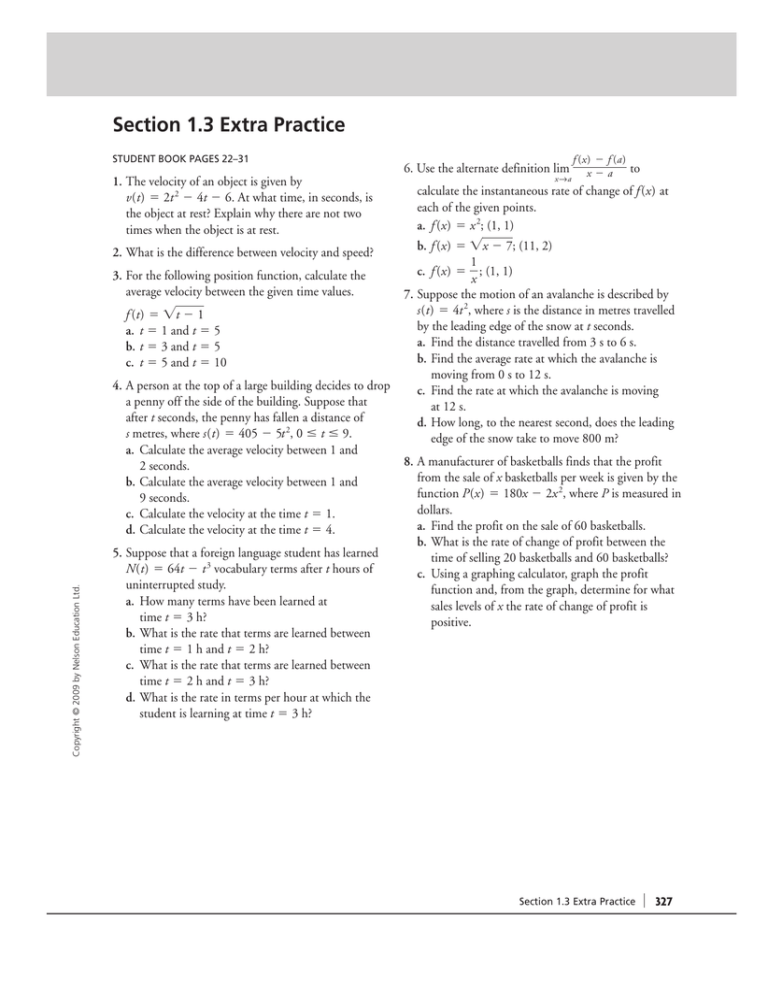Section 1.3 Extra Practice
advertisement

Section 1.3 Extra Practice STUDENT BOOK PAGES 22–31 1. The velocity of an object is given by v(t) ⫽ 2t 2 ⫺ 4t ⫺ 6. At what time, in seconds, is the object at rest? Explain why there are not two times when the object is at rest. 2. What is the difference between velocity and speed? 3. For the following position function, calculate the average velocity between the given time values. f (t) ⫽ 兹t ⫺ 1 a. t ⫽ 1 and t ⫽ 5 b. t ⫽ 3 and t ⫽ 5 c. t ⫽ 5 and t ⫽ 10 Copyright © 2009 by Nelson Education Ltd. 4. A person at the top of a large building decides to drop a penny off the side of the building. Suppose that after t seconds, the penny has fallen a distance of s metres, where s(t) ⫽ 405 ⫺ 5t 2, 0 ⱕ t ⱕ 9. a. Calculate the average velocity between 1 and 2 seconds. b. Calculate the average velocity between 1 and 9 seconds. c. Calculate the velocity at the time t ⫽ 1. d. Calculate the velocity at the time t ⫽ 4. 5. Suppose that a foreign language student has learned N(t) ⫽ 64t ⫺ t 3 vocabulary terms after t hours of uninterrupted study. a. How many terms have been learned at time t ⫽ 3 h? b. What is the rate that terms are learned between time t ⫽ 1 h and t ⫽ 2 h? c. What is the rate that terms are learned between time t ⫽ 2 h and t ⫽ 3 h? d. What is the rate in terms per hour at which the student is learning at time t ⫽ 3 h? f (x) ⫺ f (a) to x⫺a x→a 6. Use the alternate definition lim calculate the instantaneous rate of change of f (x) at each of the given points. a. f (x) ⫽ x 2; (1, 1) b. f (x) ⫽ 兹x ⫺ 7; (11, 2) 1 c. f (x) ⫽ ; (1, 1) x 7. Suppose the motion of an avalanche is described by s(t) ⫽ 4t 2, where s is the distance in metres travelled by the leading edge of the snow at t seconds. a. Find the distance travelled from 3 s to 6 s. b. Find the average rate at which the avalanche is moving from 0 s to 12 s. c. Find the rate at which the avalanche is moving at 12 s. d. How long, to the nearest second, does the leading edge of the snow take to move 800 m? 8. A manufacturer of basketballs finds that the profit from the sale of x basketballs per week is given by the function P(x) ⫽ 180x ⫺ 2x 2, where P is measured in dollars. a. Find the profit on the sale of 60 basketballs. b. What is the rate of change of profit between the time of selling 20 basketballs and 60 basketballs? c. Using a graphing calculator, graph the profit function and, from the graph, determine for what sales levels of x the rate of change of profit is positive. Section 1.3 Extra Practice 327

